“Open-minded and sociable house cat seeks flatmate!”
A cat living together with other pets in a big patchwork family – Is that really possible or does this automatically lead to stressful situations?
A kitten is socialised as of the 4th week of its life. This usually happens together with their siblings, “single kittens” are merely the exception. During this period, they learn everything about feline social behaviour and are educated by both their mum and their siblings. If a cat has grown up in that kind of species-appropriate environment, it will still go hunting alone – but for the rest of the time it will happily engage with others. In that regard, cats are very sociable animals! They love the physical contact with other cats, they clean each other and play together – also, relaxing is far more enjoyable together than alone!
- In that case, who would be a desirable candidate for your cat`s “flat share”?
- Who is the best company for your cat?
- And which two would merely “eat each other up”?…
What animals get along with cats?
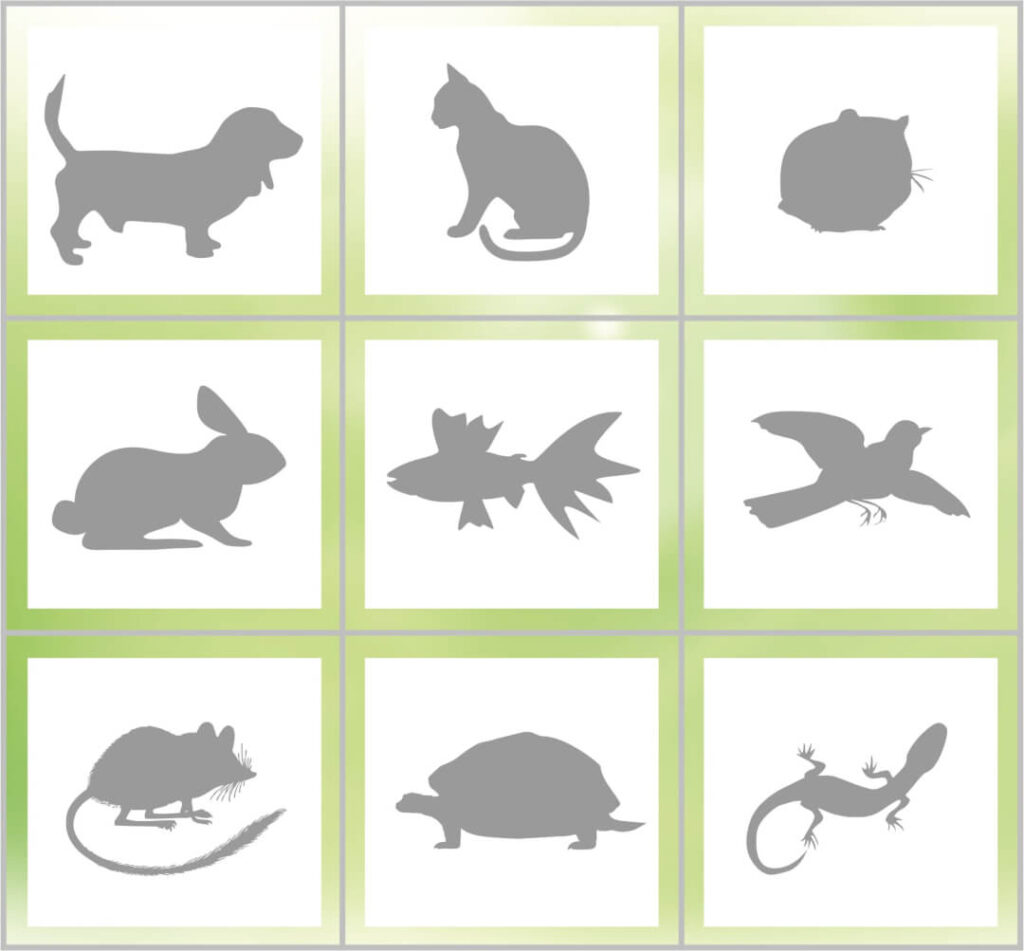
Every third German household keeps at least one pet, if not two or more.
Cats are the most common pets but they often share their habitat with other animals. But which animals get along best?
If your cat is to get company, you need to choose carefully and check who they harmonise with best on a long-term basis – otherwise the new situation can become a burden to everyone involved.
A future cohabitation of two or more animals should therefore be planned with care!
Cats and rodents
“You look so good I could eat you up!” Cohabitation of rodents and cats – at least in their natural habitat – is at best short if non-existent: Any encounter can quickly take a dramatic turn! Eating or being eaten – since rodents are natural prey to cats, their life expectancy in case of an encounter is unfortunately rather limited.
If hamsters, rats or mice share the living room with cats, you should definitely make sure that their cage is secured and safe to look at but not to touch… Permanent lurking can otherwise turn into long-term stress for both parties involved.
Cats and birds
“Separate Tables” – Spacial separation must be a given for the entire time the bird is spending outside of its cage. A few hours per day need to be reserved for them to fly and roam freely.
During that time, your cat should always be separated from them, because a bird will not keep circling close to the ceiling – at times it will land on the floor or furniture and take a rest. No matter, how well your cat is socialised and even if it usually doesn’t pay any attention to the bird – this is too tempting a situation to withstand: “Isn’t something moving on the floor there and smelling really yummy?!” This could mean that suddenly, the hunting instinct is back. Without further ado, the cat prepares to leap – and you can’t even blame it.
If you can afford to give both species their needed habitat and space, this combination can still work. However, in a one-room-flat or studio, the challenge might be a little extreme for everyone involved.
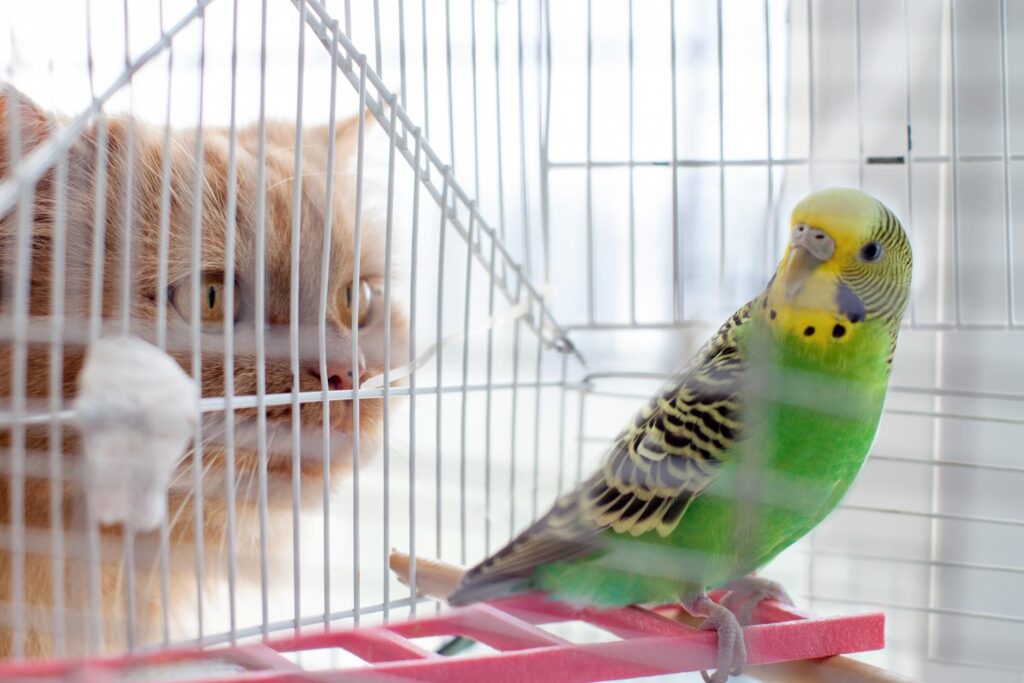
Cats and rabbits
Grown rabbits normally don’t have problems with cats, given that they are not coming too close. This would quickly be perceived as too intrusive. They would then try to withdraw – and if that is not possible or if they feel cornered, the rabbits will defend themselves, with force.
Dwarf rabbit and rabbit kids still fit into the prey category for you cat – so be watchful during the hours your rabbits are running free. Do not leave them alone and unsupervised – even when they have grown up. An open door may tempt a saint… So make sure to create a surrounding for them where they can run free but are safe from your cat at the same time; especially when alone.
Cats and dogs
“Like cat and dog” – means two that do not go together without tearing each other to shreds!! Most proverbs contain some truth – so what is behind this one? Cat and dog, living together in harmony – can we make this work? – Yes, we can!
Depending on the individual character of the animals, some breeds actually have no problem with this at all – and if the animals have grown up together, everything should be fine in any case. Though cats have learned to live with us, they preserve their hunting instincts nonetheless; and there are some dog species bred for hunting especially. But there are dog breeds that have a more sweet-tempered nature, even with cats who cross the line once in a while.
If cat and dog learn to read each other’s behaviour patterns early in life, friendships can be established that last for a lifetime.
Cats and cats
Normally, cats can get along with their own species. However, the “chemistry” must be just right! It obviously makes it easier for them if they already know each other or even stem from the same litter. But don’t be fooled: Just like in human families, siblings also like the occasional tussle. However, serious fights are not to be expected here.
If a kitten is integrated in a household with an older cat, make sure that the senior gets its rest once in a while. Even a teenager gets tired eventually – and many older cats are well capable of setting and protecting their boundaries. A female cat might even consider adopting the little fellow! It is in any case advisable to keep the cats apart in the beginning and to give them enough time to get to know each other. The hierarchy must be set and during this process, some fierce fighting can be expected. But not to worry – this matter is usually quickly settled. Just make sure to keep out of it and let them work it out among themselves.
As soon as the new order is established, the hatchet will be buried again quickly.
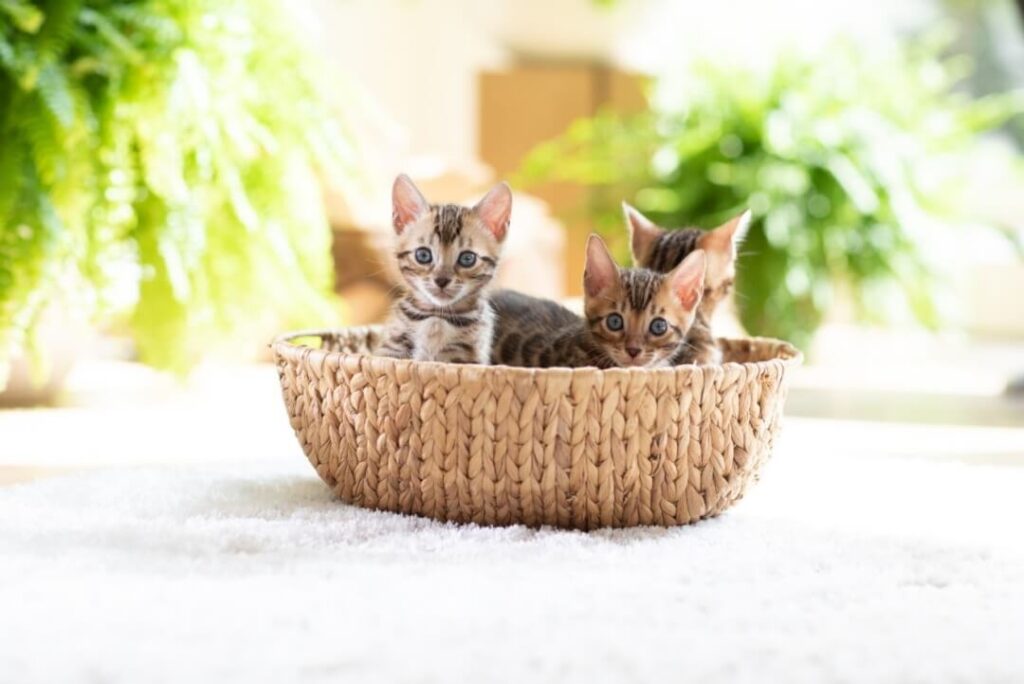
After choosing the animal
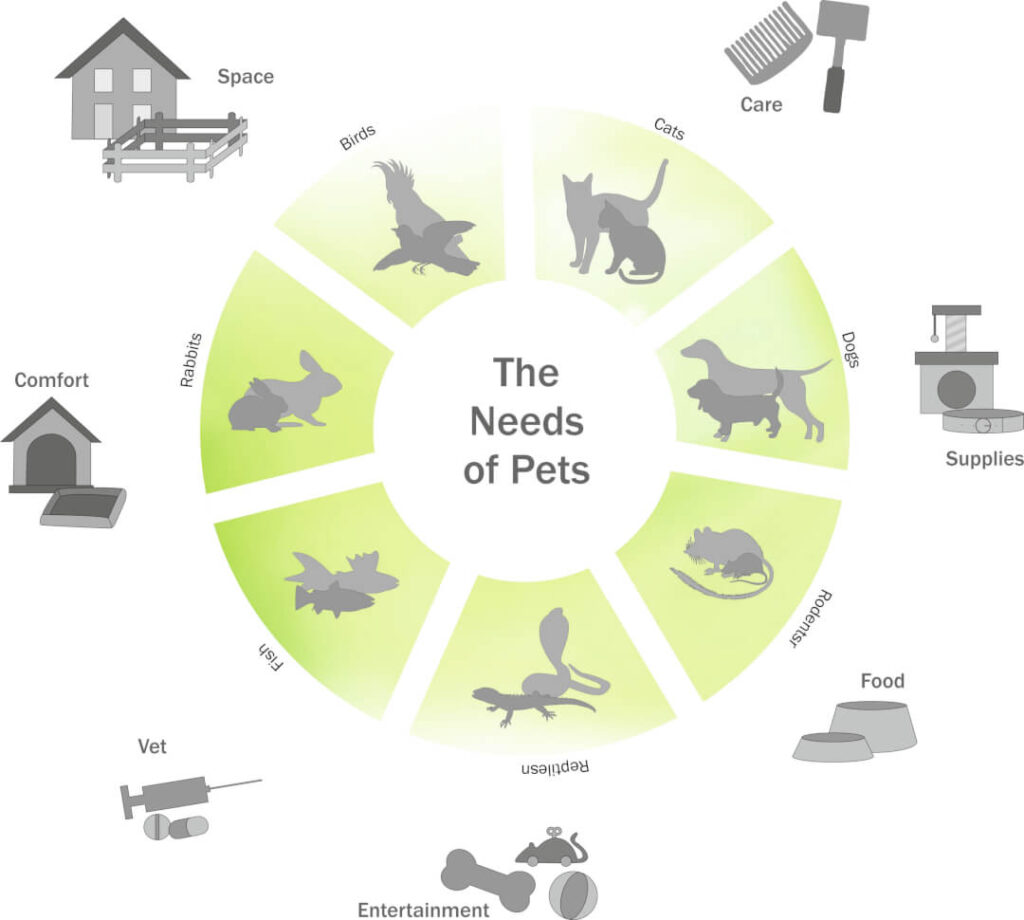
If you want to keep several animals but are not sure which one would be the best match, do not only follow your own wishes but also consider how much of a chance there is for the pets to get along with each other. What are the prospects for the new combination to become the future “dream team”?
This obviously entails that you consider upfront what kind of living conditions the cats require and if you are able to provide them.
All animals living together in peace, like on Noah’s Ark – this would obviously be ideal. But the reality often looks somewhat different and things can even get pretty dangerous! If you are considering keeping animals of the same species together, make sure upfront that the chance for success is maximised by providing ideal conditions.
Previous experience with other pets
A basic prerequisite for harmony is that no negative experiences precede the encounter – if the animals connect only positive memories with their own species, half the job is done already! In that case, there should be no fear of contact, as a basic tolerance already exists. But even here the rule applies: Every new animal needs to become part of the family.
And as each group has its own dynamics and rules, it requires sensitivity and patience to make the arrival easier for the newcomer. Cats who have had contact with other animals at a young age will usually have less problems with socialising, because a positive conditioning has already been established.
Monitoring behaviour with other animals
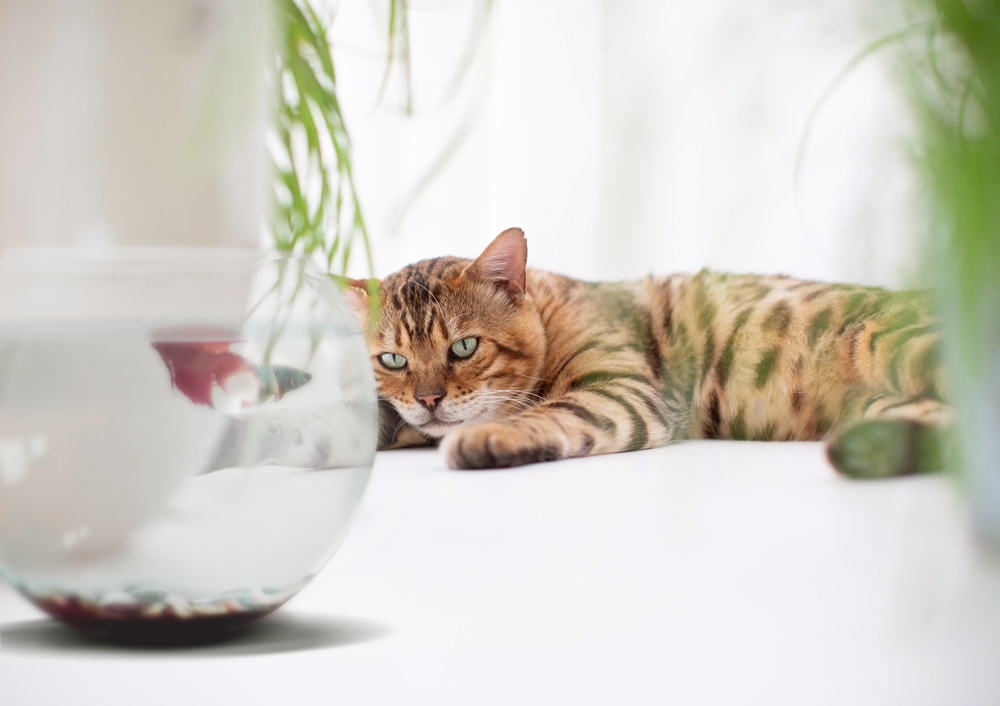
If your cat has shown aggressive behaviour and general difficulties with accepting other animals, you should consider not bringing other pets into the house. The same goes for easily stressed and frightened cats.
If your cat has a strong hunting instinct, the addition of a smaller pet to the “cat-share” is an equally bad idea. Watch the body language and the size of the pupils! This scenario could quickly lead to permanent stress for both the animals and you – as you would not be able to leave them alone for one minute without having to fear for the worst. And with that being practically impossible, the catastrophe is virtually predestined.
The “prey” would have a very limited life expectancy…
Look for a good match
But even the most “dog-proof” cats won’t necessarily get along with any dog. The character of the pet is of the utmost importance!
An old cat may always have been getting along well with an elderly, white-snouted dog and may even have snuggled in front of the fire with it – but it wants nothing to do with the young puppy and its boisterous attacks!
Before, a wink of the eye was enough communication between cat and dog – the two were a well functioning team, getting along quite smoothly. “But this young rowdy won’t leave you alone, even if you arch your back and hiss at it – no fun at my age in the first place – and I constantly have to defend myself. All I can do is withdraw. “Joyful old age looks different!” an old cat might think.
Conflicting body language
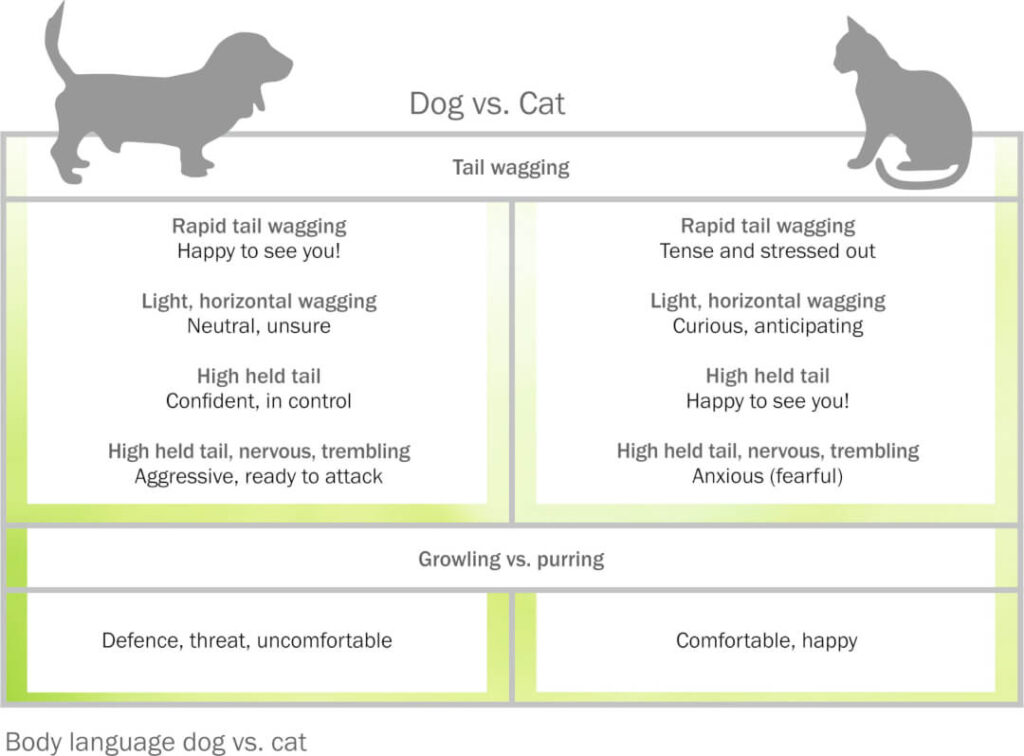
Surely, the fact that varying species avoid each other in the wild is problematic. An encounter is made even more difficult by conflicting body language – the most basic signals can be read completely differently – between cat and dog they can even mean the opposite!
The more relaxed and calm the introduction, the easier the next few weeks of adaptation will be – for everyone involved. Try and be as easy-going as you can, because your fine-tuned animal will register any change of mood and react accordingly. Emotional highs and lows are something that your pets will pick up with their antennas immediately – and they will always respond to whatever is “in the air”.
Growling or purring? When a cat purrs with delight, the dog may anticipate this as a dangerous snarl – just to give an example. (However, there are also purring dogs…hard to believe, but true!)
Misconceptions are very 0new and stressful, all parties – and that includes you – should enjoy an uninterrupted night’s sleep, to gather strength for the next day. Even if the newcomer already moves around quite confidently in the new environment during the day – at night it should still have a place all to itself, with no danger of intrusion. This private sphere is immensely important!
If there are cases of friction and confrontation, a safe refuge is important even during the day! A secure place to retreat to can be a lifesaver – even if things get tough; here your newcomer will feel safe and snug. And that exactly is the feeling that’s missing for the newcomer: feeling safe.So please try and create one or several peaceful retreats. The resting place must be taboo for everyone else, at all times! This is a private zone – “Entry strictly prohibited”.
Passive encounter
Few animals will happily great new arrivals on their first encounter – as in “Where have you been all my life? Nice to finally meet you!” Rather, the newcomer will be perceived as trespassing on the territory. Therefore never let them meet each other without warning – even if they are members of the same species – in most cases, this will not work out!

The “new one” will be stressed out from the trip and the new territory, with strangers – both two-legged and four-legged – whom it has not met before. Wouldn’t your own first thought possibly be: “Run, if you can’t hide!”?
To feel safe, first of all a quiet room should be provided. There should also be food and water, maybe a litter box (if the newcomer is a second cat) and a comfortable basket, so that the newcomer can take its time to arrive and get some rest. The first night may be sleep-deprived nonetheless…since all of this is much too nerve-wracking as it is!
Further tips for cohabitation:
- Maybe you can ask a friend to become godmother/-father to one of your pets and be there for it alone? – best would be someone who already knows the animal.
- Provide a comfortable, relaxed atmosphere – no loud noises, no visitors, no hustle – all of that could stress the animals even more.
Getting used to scents
Act carefully and let your newcomer get used to the scent of those who have lived on the territory before actually meeting them. And vice versa, of course. Not only does a cat smell much better than a human – but their olfactory sense is much more developed – meaning they can literally “see” someone with their noses. This serves the situation perfectly! For the passive encounter, this is the first step:
Before the protagonists meet in person, they can thus get used to each other via their respective smell – that means, they know each other to an extent before actually having met. If they then meet for the first time, they may not be great friends automatically – this is obviously not possible – but the scent of the other animal seems at least familiar and non-threatening. The first baby step has been taken – via the nose.
Positive conditioning by help of scents
Positive conditioning can encourage and consolidate a certain desired behaviour. Praise them if they have shown the right reaction, or even reward them with a little treat! It will leave a positive impression because it is connected with the reward.
In order to initiate the positive conditioning you can for example gently rub the cheeks of the newcomer with a cloth and let your “old” housemate smell it afterwards. If your cat shows curiosity and smells the cloth, praise and reward it thoroughly!
This is how you conduct the approach to the new “fragrant messages” – because these are important steps for getting to know one another.
TIP: Best to bring a cloth or blanket of the new housemate and deposit it at home a few days in advance!
You can also connect a relaxing verbal signal – a certain word or command – with the scent of the newcomer: Especially during the first period of adjustment, this can be very helpful with easing tense situations.
Spreading the fragrance around the feeding bowl.
“Food is ready!” – Feeding time for a pet often equals the highlight of the day! Even the favourite spot will be deserted when it comes to being first at the food bowl. You may know the feeling of a stare “drilling” into your back while standing at the opened fridge – and whoosh! Suddenly your cat has materialised out of nowhere.
“I happened to be in the area – would a quick snack be possible, maybe?” Obviously garnered with a glance from velvet eyes that can dissolve steel and stone in a flash…
somewhere routed in the genes, passed down from generation to generation and simply irresistible! You can open your fridge or cupboard as soundlessly as possible – Your animal will already be there, circling your legs. But this time, the evolutionary imprinted greed is actually helpful!
To connect the fragrant of the newcomer with something pleasant, you can position it in a way which yields positive conditioning: Place the scented cloth or blanket in the feeding area, or present it during play or cuddling time – that way, the scent will automatically be connected with positive experiences. By the time the first encounter happens, the scent emanating from the newcomer will be loaded with positive sense memories.
Staying in each other’s space
After keeping the animals in separate rooms for a few days, you can risk an interchange: Each animal is invited to check out the territory of the other. By sniffing every corner of the room, the two animals will get to know each other in absence, via the nose.
A whole room will smell much stronger than any cuddle blanket, at least for fragrance-sensitive animals. We as humans only register these things marginally, while animals will smell each other even after days of airing!
The animals will thus be confronted more intensively with the unknown odour – without the threat of a physical encounter. However, by the time they meet “in person”, the “total stranger” will almost seem like an old acquaintance.
This process initiates the actual “getting to know each other” in a very gentle way – and will make the first “face-to-face” encounter a lot easier – for all parties involved.
Using the other animal’s blanket
Sleeping blankets or cushions are especially perfect for this, because our feline friends spend much of their time in and on them. For cats that are not out hunting, the sleeping place is a haven during the night as well as for many cat naps during the day – quite obvious that these spots are full with odours!
Here, not only the biggest amount of their time is being spent – but it is also used for rolling about and cuddling – all of this leading to a lot of messenger substances being released. Many dogs will start scraping at their nest to change it to the their liking – much as in the wild, where they would dig up a hollow to sleep in. House dogs only mimic this with a symbolic gesture – thank goodness – as no house owner will look on benignly while “Bello” is digging up the parquet floor…
During this scratching activity – similar to cats rubbing their cheeks on something – messenger substances are being released from the paws to mark the territory. Place the fragrant blanket in the house a couple of days ahead of the arrival of the new pet. This will give the “old” four-legged housemates enough time to get used to the new odour.
Adjustment by ear
Silence of the lambs? Not in the least – pets can be loud, and how! Every animal has a whole repertoire of sounds at its disposal. These can be used as a kind of audio business card – given that there are unique sounds that are typical for the respective newcomer.
With cats and dogs, this is quite easy; here you can record their meowing or barking. But also small animals make a lot of distinct noises such as the high, piercing squeak of the guinea pig or the lighter pitch of a mouse or rat (no! – do not squeeze – they will deliver the sound voluntarily!)
In any case, you should usetypical sounds with a high recognition value.
The sounds must be clearly recognisable – admittedly this is a little harder with rabbits and other small animals, but the main goal is to get them used to the noises of cats or dogs. Afterwards, the bigger animal will appear much less threatening!
Playback of pre-recorded animal sounds of the newcomer
The animal sounds are recorded and then played back, beginning with a low level – then you increase the sound until a realistic volume is reached.
If you conduct this audio performance carefully, a loud bark may still be threatening – especially if coming from a 60 kilo strong resonance body – but at least it will not scare the wits out of your animal completely any more – because by now, it now somehow seems at least familiar.
A good old tape recorder will do the trick as well as any dictation device, a mini disc recorder – or you can simply use the notes/recording function on your smart phone. Place the recording device in the vicinity of the animal and play the sequence from time to time – no need to pester the pet with a non-stop soundscape though, as that might be rather counterproductive!
Too much will produce aversion! Please stick to a bearable dosage and volume level – otherwise your neighbours might start complaining…
Spatial separation
The animals should be living apart from each other in the beginning, with the newcomer getting a room of its own and the “old” pet roaming the rest of the premises. Each room obviously gets a food and water bowl as well as a litter box. The old territory should be kept available – to avoid resentment. The “old” cat should still be number one, even though a potential rival has arrived. All of that is very stressful for a cat – do not underestimate its feelings!
Obviously, anything new is attractive – especially if it is a fluffy kitten with big eyes and soft fur, looking so sweet, demanding all of your attention and assistance! But do not make the mistake of neglecting your “old” cat! It is not helpful to regard them as extras or boss them around – this does not work with cats any way! They will never “function” according to your will.
Include them and spoil them so that they don’t feel left behind. When you have visited the newcomer in its own room, always make sure to spend some quality time with the other pet as well.
Separate bedrooms
As the whole new situation is”F>– But remember, praise is often more effective than punishment!
An elevated spot for the food bowl
Friendship often ends where feeding begins.
As to avoid resentment, simply place the food bowls in separate rooms and keep the door shut! An open door may tempt a saint… There are enough cats who won’t hesitate to steal from right under their housemate’s nose! To them, impudence wins the game and is also a way of showing dominance. To avoid bullying and make sure that the new pet does not end up looking like skin and bones, simply place the food somewhere else and that’s that! That way, the newcomer must not risk life and limb to defend its food.
Here, the new pet can eat in peace and without interruption – an important factor of feeling at home. This is not just about nutrition – food distribution is a matter of hierarchy – the highest ranking animal gets to eat first.
In one house with cat and dog, you should feed your animals at different times in different rooms to prevent jealousy. You may also want to place the food bowl for the cat higher than the one for the dog especially when you give it dry food, which will not be consumed in one go. Otherwise, the dog might be tempted to dig in at intervals.
Many dogs just love cat food! Wonderfully different in variation! And tasty fish dishes…
Protecting the litter box
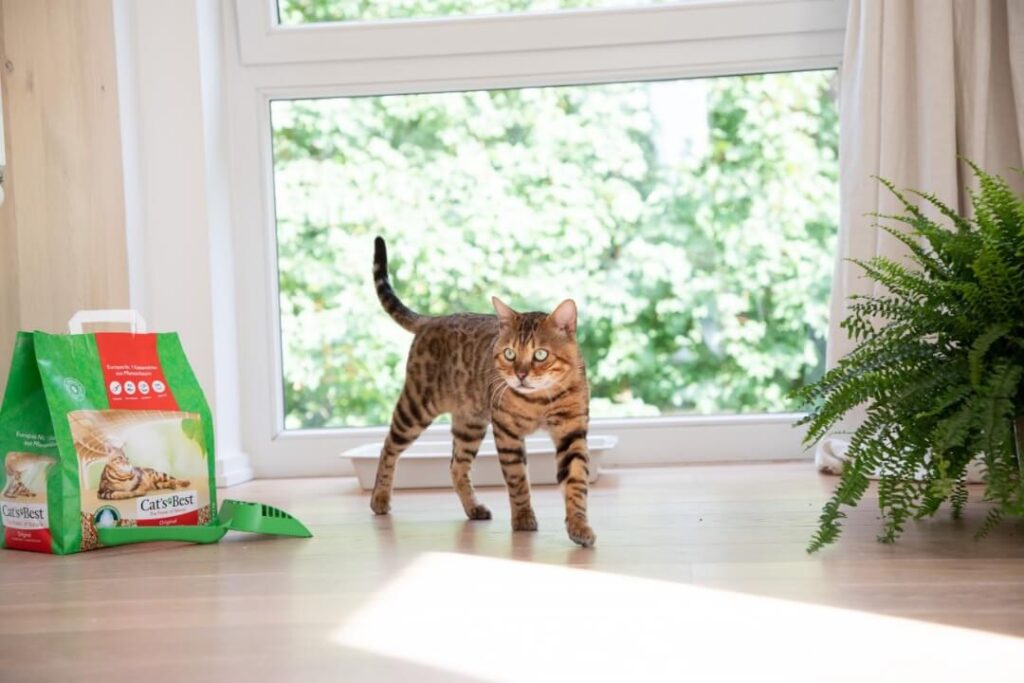
The cat’s toilet should always be taboo for other pets!
Cats can be very peculiar when it comes to bathroom habits. Choose a place for your cat’s litter box which allows for discretion. Also avoid placing it near the feeding area, or in a spot where noise or other sudden interruptions may occur, e.g. near a door, washing machine or tumble dryer.
Many cats are very sensitive to interruptions of their private sphere. Also, some dogs have the habit of “cleaning up” after them! That a dog will go near the litter box is a no-no in itself. But then to mess with it – that is the last drop for a cat!
Some cats react with avoiding the litter box altogether from then on and start choosing other spots…
Open Sesame!
As soon as the animals have adjusted to the new situation, you may open the door.
A protective safety gate has proved to be useful: Thus, a first face-to-face can be made possible without a direct, physical contact.
Anything is possible now – from sympathy through to aggression! Don’t be surprised if the first fleeting encounter is not running smoothly. A growl, a snarl or a hiss – noisy resentment may happen – even the odd hit with the paw. That is absolutely fine if it is not repeated. This keeps the counterpart at a certain distance – a warning shot, so to speak.
Now you can open the door – still with the safety gate in place – for several minutes each day. If that goes smoothly, the “old” resident may be allowed access. If this passes without a serious escalation – be it fight, hunt or mobbing – then you’ve made it: You can now remove the gate and keep the door open.
All of this however may not happen in a flash (though the much quoted exception as ever makes the rule) – in some cases it can take days if not weeks on end.
TIP: As exciting as all this may be, try and stay calm and avoid erratic movements: There is no rush! Otherwise, your nervousness may affect the animals and make the process even harder.
Dog and cat getting used to each other
Who was here first? – Dog or cat?
This question is of great importance if dog and cat need to get along with each other. As a member of a pack by nature, dogs are usually a little more open to the idea. Cats however don’t think much of newcomers in general – and that applies not only to other species but also to their own. In most cases, they are simply “not amused”. Having said that, it may also be a matter of gender, age and character.
While a dog, as a highly social creature, may accept a new member to the family soon enough, most cats will be sceptical and regard the new arrival as an intruder of their sphere. To introduce a cat to a household with a dog is therefore usually easier than the other way round.
If you are planning to share your home with both cat and dog, you should try and follow the above procedures and conduct the introduction as gently as possible, by keeping the animals apart and only slowly bringing them together – step by step. Allow enough time for them to smell each other, as the scent usually is the entry ticket. Both of the creatures have extremely sensitive noses – dogs even more so than cats – and will immediately know that there is someone else around, simply by sniffing the air. Also: Keep the same daily rhythm and well-known rituals – for both. This guarantees a feeling of security.
Keep the dog on its leash
It is a bad idea to put the cat or even both animals into the box for an encounter – or to hold the cat on your arm while “introducing” it to the dog. This is practically the worst possible start the animals can have! (Even though I can already hear the old catch line: “But we have always done it that way and it worked!”
That may well be the case, but no two cats are the same and offering good advice means to prevent the worst case scenario. Again – there is no doubt that the exception makes the rule!
Surely you have taken your animal to the vet in a travel box before – and that means pure stress for your cat! Stuck in a box with a multitude of other animals around is never enjoyable. Especially, if there are dogs nearby – not exactly the species they are most friendly with in the first place – yapping and staring at them.
There is only one wish for the cat: Out of here! – and it is not possible.
MUCH BETTER:
Put the dog on the leash and take it to the middle of the room. Now the cat can approach freely; it will decide when to come in and how close it wants to get to you both. In most cases, the cat will chose a safe spot from which to watch and assess the scenario. Observe, how both of them are reacting – and praise neutral to positive behaviour.
Presence of trustworthy persons
During the first encounter, you should not be on your own if possible.
If a person is present whom you trust and in the best case is an “animal person”, you have some reinforcement when things get out of hand. Knowing this will relax both you and the situation upfront. Now, after having secured the dog by putting it on the leash, the cat may come in:
Open both door and safety gate and make sure that the cat has enough options to retreat – to feel safe; it may prefer emigrating to higher ground, i.e. shelves, wardrobes or scratching posts – given they are high enough. Please make sure that your cat has unlimited access and keep those surfaces free of clutter. Otherwise a few breakables may fall victim to panic and flight. Afterwards, all items may be safely returned to their usual spots.
In case of straight out antipathy in the beginning and things going awry, it is good to have someone by your side who has the pluck to jump in and help you with keeping the opponents apart. – However, this is only necessary when things really get out of control!
All eyes on the animals
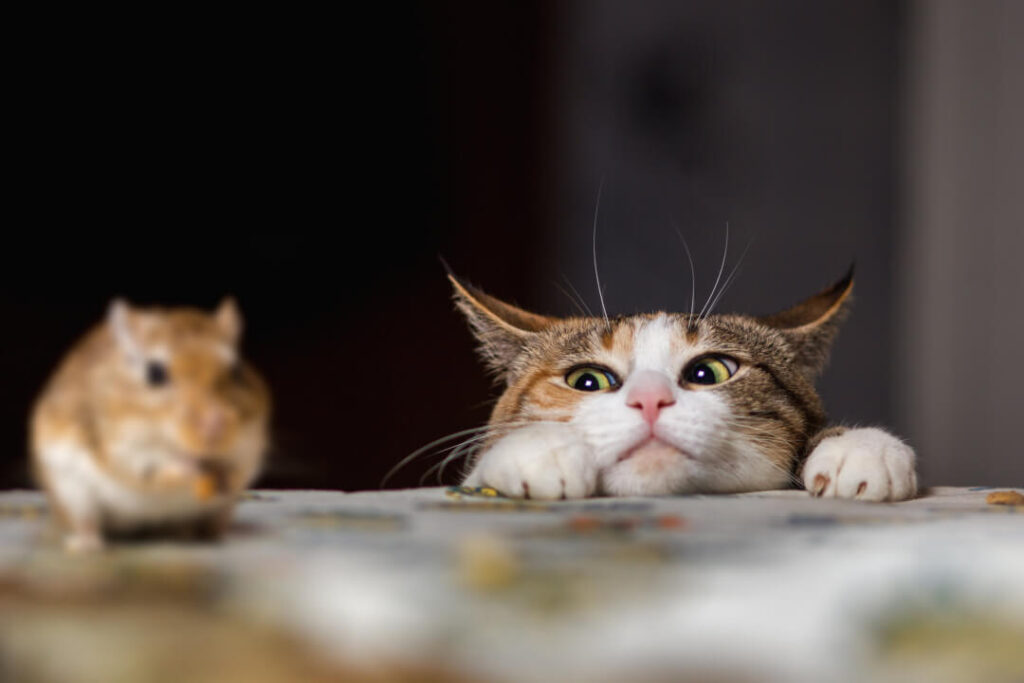
Watch both animals closely – however, do not overreact to any small sign of irritability!
“Helicopter animal keepers” like to overdo it – with the result that the cohabitation may not work out.
The more relaxed and calm the introduction, the easier the next few weeks of adaptation will be – for everyone involved. Try and be as easy-going as you can, because your fine-tuned animal will register any change of mood and react accordingly. Emotional highs and lows are something that your pets will pick up with their antennas immediately – and they will always respond to whatever is “in the air”.
When a cat meets a dog in the wild, it will try to escape. The dog might enjoy hunting after it for a while but usually gives up when the cat reaches higher ground. From here, the cat will watch the dog for a while, the tip of its tail flinching in anticipation – still nervous but not panicky or afraid to death. With the space at home being naturally restricted, a confrontation is sometimes unavoidable: A hiss, a growl or a quick stroke with the paw to show dominance still counts as “tolerable cat behaviour”; also a yapping dog straining forward is acceptable. Don’t worry – this will ease up after a while.
Growling dog? Reward your cat
Even if weeks have gone by without confrontation and the two have gotten used to each other – misunderstandings may still happen. This is due to the conflicting body language of the two species, or may be the result of jealousies. The newcomer will still be regarded with suspicion at times – especially when it comes to feeding or cuddles from your side. Try and be fair with giving out these tokens of affection so that none of the animals will feel rejected. Especially the pet who was the first on the premises should never be put in second place or bossed around. Setting boundaries doesn’t count, if the behaviour warrants it.
If the dog is growling at the cat, simply lure your feline friend to come to your side and reward it. That way it will understand that it can relax even if confronted in that manner and will automatically approach you the next time – which will also be helpful if the dog decides to go after it. Thus, you can defuse the situation – as the cat is definitely safe with you.
To enhance the praise you can use treats, or simply your voice or cuddles to anchor positive behaviour:
Reward friendly behaviour on both sides
As soon as the first encounters take place, this should happen within a peaceful, comfortable atmosphere. Thus, the animals will connect encounters with a good feeling: “It may be a dog, but it is not as scary as anticipated,” And: “That cat does not run away from me – maybe it doesn’t have to? No fun running after it then.” Or: “This seems to be our own cat now – so I will try and protect it just like the rest.”
A bit of tearing and pulling on the leash during the first phase may still be happening and is OK! It is a dog after all. Rather distract than punish it. Give calm yet distinct instructions and only praise the dog when it calms down and behaves in a more relaxed way. Reward it when it does a good job at being more serene – in that case, a special treat is not out of place!
Watch out: Some dogs may grab the treat only to resume the attack afterwards – make sure to reward the animal only if the behaviour is one hundred percent reliable and not a matter of chance. – The same obviously goes for the cat!
Interrupt negative behaviour and separate the two pets
Sometimes, a situation builds up out of nowhere and becomes aggressive – for whatever reason! That may happen quickly and all you can do is stand amazed.
If that is the case and one has to fear for things getting out of control, make a “cut!” – at once! Don’t wait for one of them to get hurt. The verdict is: Act swiftly and separate the opponents. No matter who started it. Try not to overestimate slips like these! There will always be “bad days”, even if things are normally running smoothly.
Better to wait a while, until the waves of aggressions have subsided. Only then it is time for the next attempt.
Grant your animals the right of being moody. They can’t be the same every day. Often, it depends on the mood if and how an attempt of socialising works out: Today is a no-go; but tomorrow we might be great friends again!
The exception: If rivalries or attacks increase or become the rule, the alarm bells should be ringing loud and clear: A harmonious co-living situation may not be possible after all. In that case, a solution must be found for the benefit of the animals, even if this is hard for you. If you are uncertain, ask an expert such as a coach or vet – or an animal psychologist.
Grant your pets a break
The first encounter should never take longer than a few minutes. Just enough time to get a first impression: “Aha! So that is the new housemate!”
Don’t ever leave the animals alone with each other; stay with them for the entire duration. In the beginning, a maximum of five minutes is often enough, then you can carefully extend the meetup bit by bit: If you realise that the animals react calmly, you can leave them together for ten to fifteen minutes at a time.
No rush though! – Slow and steady is the rule. Observe closely how the animals behave and watch their body language. Keep in the background but always be ready to step in when needed.
Everything takes the time it needs, so try not to push things. The animals usually know best when they are ready to share their home with another pet. At some point, curiosity will win over reserve… The more time the velvet noses have to get to know each other, the better the chance of getting along. Allow for three to four weeks to make it happen.
Precaution is better than mending wounds
Animals know all about jealousy and envy. Feelings of neglect are not to be underestimated: Suddenly not “number one” any more – how on earth did that happen? Such a thing is hard to understand and can lead to withdrawal and fasting – in short, depression. But it mustn’t come to that!
Even if the newcomer is interesting to an extent because, well, it is something new, and may be even a cute little puppy or kitten – the “older” resident will always want to maintain the rights of “the one who came first” – the king or queen of the castle. Attention and cuddling should not decrease – on the contrary; more is more in this case. This helps a lot to prevent uneasiness and the fear of becoming the odd one out.
Resting and feeding areas should be in separate places for the two pets, so that each has its own “realm” or “sanctum” – exclusive and safe from any form of intrusion. By placing these spots well apart from each other, you can avoid mobbing – which the newcomer might otherwise automatically be subjected to.
TIP: Spend the same amount of time with both pets, so that no one feels neglected.
New pet, new luck
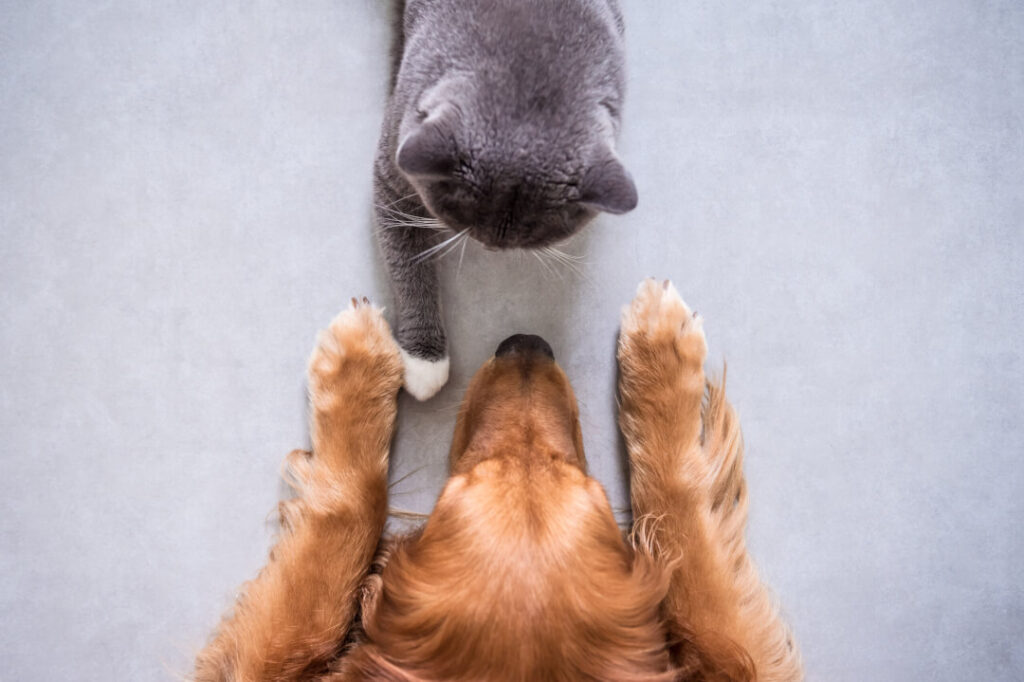
Be aware that any newcomer to your household also triggers a new order. This means that even animals who used to get along fine all of the sudden might start bickering again. The roles are newly distributed and – depending on situation and time – can always be overturned again. Such an animal team is of a dynamic nature – nothing is ever set in stone.
For example, if one of them dies or goes missing, the team will react accordingly. By the way – animals grieve, too …and opponents often become friends for life, who will be sadly missed.
